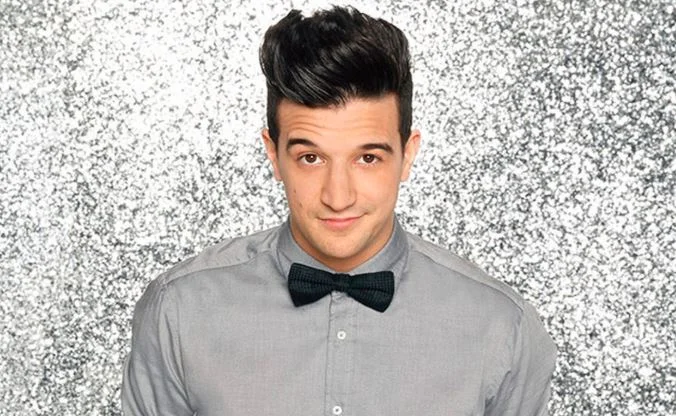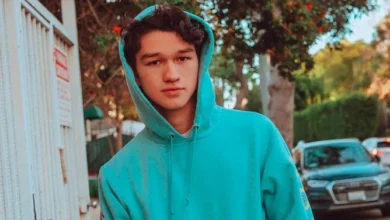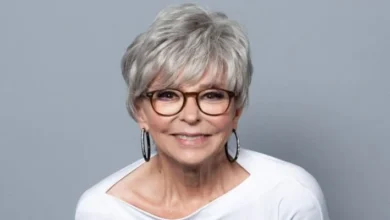
Mark Ballas Ethnicity and Parents Nationality
Mark Ballas is a prominent American professional dancer, choreographer, and musician, widely known for his appearances on the television show Dancing with the Stars (DWTS). Throughout his career, Mark has made a significant impact on the dance world with his skill, creativity, and charisma. While much of the focus is often on his dance moves and performances, less is discussed about his background, including his ethnicity and the nationalities of his parents. Understanding the cultural influences that shaped him gives a deeper appreciation of his multifaceted talent and identity.
Mark Ballas Ethnicity and Cultural Background
| Category | Actors |
|---|---|
| Full Name | Mark Ballas. |
| Birthdate | May 24, 1986 |
| Birthplace | Houston, Texas, United States. |
| Ethnicity | mix of English, Mexican and Spanish descent. |
| Father Ethnicity | English descent. |
| Mother Ethnicity | Mexican and Spanish descent. |
Mark Ballas’ ethnicity is a distinctive fusion of European and Latin American heritage, which has deeply influenced both his personal identity and professional career. Born on May 24, 1986, in Houston, Texas, Mark hails from a family rich in cultural diversity. His paternal ancestry traces back to England, while his maternal roots are Mexican and Spanish. This unique combination of ethnic backgrounds not only reflects the multicultural world in which Mark grew up but also plays a central role in shaping his approach to dance, choreography, and artistic expression.
Mark Ballas Paternal Background English Roots
Mark’s paternal heritage is rooted in English ancestry, which ties him to the traditional European ballroom dance culture. The English influence in his background has exposed him to the structured and refined dance forms that are typically associated with ballroom dancing. These techniques and traditions have been essential in developing his skills as a professional dancer. Growing up with an understanding of classical ballroom, Mark was able to master the techniques required for dances such as the waltz, quickstep, and foxtrot, which he often showcases on shows like Dancing with the Stars.
The English side of his family not only contributed to his technical dance training but also influenced his taste in music and performance style, instilling in him a respect for elegance and precision.
Mark Ballas Maternal Background Mexican and Spanish Heritage
Mark’s maternal side is where the Latin American influence comes into play, with his mother, Shirley Ballas, having Mexican and Spanish roots. This side of his heritage introduced him to the passionate and expressive dance forms typically associated with Latin America, such as salsa, cha-cha, rumba, and tango. Growing up with this cultural influence, Mark developed a natural affinity for rhythmic, sensual dances that require flair, energy, and emotional connection.
The fusion of Mexican and Spanish heritage also exposed Mark to the vibrant musical traditions of Latin America, where rhythm and melody are integral to the culture. This background provided him with a rich palette of musical styles and movements to explore in his choreography.
Mark Ballas Impact of Cultural Heritage on Dance Style
Mark Ballas’ mixed European and Latin American heritage has enabled him to create a dance style that is both versatile and dynamic. His deep understanding of European ballroom traditions, paired with his passion for Latin rhythms, allows him to seamlessly blend the elegance of traditional dances with the energy and intensity of Latin styles. This fusion is a key aspect of his success as a choreographer and dancer, particularly in his performances on Dancing with the Stars.
The Latin American influence, with its focus on rhythm and expressive movement, has been particularly important in Mark’s ability to perform and choreograph dances that are full of passion and flair. His background gives him an innate ability to convey emotion through movement, something that is crucial in dances like salsa and cha-cha. The European side, meanwhile, provides him with a foundation of structure and technical precision, ensuring that his performances are not only expressive but also refined.
Mark Ballas Latin Dances in Dancing with the Stars
Throughout his time on Dancing with the Stars, Mark has showcased a range of Latin dances, often incorporating his mother’s cultural influence. He is known for his ability to bring out the excitement, precision, and sensuality required in these dances, which often include the cha-cha, salsa, rumba, and paso doble. The Latin American influence is especially evident in the way he combines intricate footwork, passionate movements, and vibrant expressions to create compelling performances.
These dances have allowed him to stand out on the show, earning him multiple awards and accolades. His unique ability to fuse Latin rhythms with classical ballroom styles has made him a standout choreographer, able to adapt his performances to the diverse musical genres and themes presented on the show.
Mark Ballas Siblings and Family Life
While Mark Ballas is well-known for his success on Dancing with the Stars and his impressive career as a dancer, choreographer, and musician, his family also plays an important role in his life. Mark was raised in a household that fostered creativity, discipline, and a love of dance, surrounded by his parents and siblings. He has one known sibling, a sister, who shares the family’s love of performance.
Mark Ballas Sister Julianne Ballas
Mark’s younger sister, Julianne Ballas, often appears in discussions about the Ballas family, though she doesn’t publicly engage with the dance world as Mark does. While Mark pursued a professional dance career, Julianne chose a more private life. However, she frequently attends family gatherings and remains an integral part of the close-knit Ballas family. Although she stays out of the spotlight, her connection to a family deeply rooted in dance and performance has undoubtedly shaped her environment.
Julianne grew up in a household dominated by competitive dance, with both parents excelling as renowned ballroom dancers. While public details about her career remain limited, her upbringing suggests she shares a passion for artistic expression and the performing arts, even though her path diverged from her brother’s professional trajectory.
Mark Ballas Family Influence
The Ballas family’s dynamic, rooted in both English and Latin-American heritage, shaped Mark and Julianne with a unique foundation. Their parents, Shirley Ballas, a champion ballroom dancer, and Corky Ballas, a successful dance professional, immersed them in a rich cultural background of dance from a very young age. Shirley and Corky’s expertise instilled in both siblings a deep appreciation for dance and its many forms.
Mark rose to fame through his dance career, while Julianne, though more private, likely thrived in the same inspiring environment. The Ballas siblings share a bond rooted in their mutual love for dance and performance, even if their connection remains largely out of the public eye.
Mark Ballas Professional Career
Mark Ballas is best known for his role as a professional dancer and choreographer on the popular television show Dancing with the Stars (DWTS), but his career spans much further than this reality show. With roots in competitive dance, a passion for choreography, and a deep understanding of both contemporary and classical dance forms, Mark has built a diverse and impressive career in the entertainment industry.
Mark Ballas Early Life and Dance Training
Mark Ballas was born into a family with a rich dance background. His mother, Shirley Ballas, is a former ballroom champion and a renowned dance coach, while his father, Corky Ballas, is a professional dancer and choreographer. Growing up in this dance-centered environment, Mark was introduced to the world of dance at a very young age. He started training in various styles, including ballroom, Latin, and contemporary dance, honing his skills and preparing for a professional career in the field.
Mark’s training began when he was just 11 years old, and he quickly showed promise in competitive ballroom dancing. He went on to study at prestigious dance institutions and participated in numerous dance competitions throughout his youth. His early dance training, combined with the guidance of his parents, helped him to gain a solid foundation in the art of dance.
Mark Ballas Rise to Fame on Dancing with the Stars
Mark Ballas skyrocketed to fame in 2007 when he joined Dancing with the Stars (DWTS) during its fifth season. The reality competition pairs professional dancers with celebrities for a series of dance challenges, giving Mark the perfect platform to showcase his skills on a global stage. His energetic, creative, and technically precise performances quickly captivated viewers.
In his debut season, Mark partnered with actress and singer Sabrina Bryan. The duo became instant fan favorites, impressing audiences with their chemistry and dynamic dance style. Although they faced an early elimination, their performances set the stage for Mark’s future success on the show.
Mark’s most notable success came in Season 6 of Dancing with the Stars when he won the Mirrorball Trophy with his partner Kristi Yamaguchi, an Olympic gold medalist figure skater. This victory catapulted him into the spotlight and solidified his reputation as one of the show’s top choreographers. He later went on to win another Mirrorball Trophy in Season 8 with his partner, former Full House star, Shawn Johnson.
Mark’s ability to adapt his choreography to suit the unique talents of his celebrity partners has been a major factor in his success. Whether working with seasoned dancers or complete novices, Mark has been praised for his innovative routines and his ability to create dances that tell a compelling story, resonating with both judges and audiences.
Mark Ballas Choreography and Dance Style
In addition to his work on Dancing with the Stars, Mark Ballas has made a name for himself as a highly sought-after choreographer. He is known for his versatility, blending various dance styles into his routines. Whether it’s traditional ballroom, Latin, contemporary, or even hip hop, Mark’s choreography is always fresh and original, incorporating his vast knowledge of different dance forms.
Mark is also recognized for his creative vision and his ability to incorporate storytelling into his dances. He often uses his routines to express emotions and tell a narrative, making his performances stand out from others. His ability to combine technical precision with artistry has made him one of the most respected choreographers in the dance world.
Mark Ballas Music and Other Projects
Beyond his work in dance, Mark Ballas is also a musician and songwriter. His passion for music has always been closely tied to his dancing, and he has released several music albums, often incorporating his love for jazz, rock, and blues into his songs. In 2011, Mark released his debut album HurtLoveBox, which features a mix of pop and rock elements. His music career has allowed him to showcase another side of his artistic expression, and he has performed on various platforms, including the DWTS stage.
Mark’s multifaceted career also extends to acting. He has appeared in various television shows and movies, with roles in Dancing with the Stars spin-offs, as well as other productions. His ability to wear many hats in the entertainment industry has made him a well-rounded performer and a valuable asset in both the dance and music worlds.
Mark Ballas Mentorship and Influence
Mark mentors many up-and-coming dancers, guiding them through the intricacies of competition and performance. On Dancing with the Stars, he inspires countless aspiring dancers with his supportive teaching approach. His deep understanding of dance’s technical aspects, combined with his natural talent for choreography, establishes him as a respected figure in the industry.
Mark actively shapes the dance community through his work with academies and workshops. He coaches and choreographs for dance schools, nurturing new talent and helping young dancers refine their skills. As a mentor and educator, he pushes the boundaries of dance, encouraging experimentation with various styles and techniques.
Mark Ballas Personal Life and Continued Success
Throughout his career, Mark Ballas has remained committed to his craft, continuing to evolve as both a dancer and a choreographer. His dedication to perfecting his skills and expanding his artistic abilities has earned him a place among the top dancers in the world. In addition to his DWTS success, Mark has performed on stage in various live shows, including professional dance tours and performances with other celebrities.
Mark’s professional career has been defined by his versatility, passion for dance, and ability to create meaningful, impactful performances. From his early days in dance training to his global recognition on Dancing with the Stars, Mark has made an indelible mark on the world of dance and entertainment. Whether on the competition floor or behind the scenes choreographing routines, his influence continues to shape the landscape of modern dance.
Mark Ballas Parents Nationality
Mark Ballas’ mother, Shirley Ballas, is an iconic figure in the world of dance, known for her remarkable achievements in ballroom dancing. Born in England to a family of Mexican and Spanish descent, Shirley’s dual cultural heritage played a significant role in shaping her understanding of dance and music. Her Latin roots brought a flair and passion to her dance style, while her English background offered a disciplined, refined approach to technique. As a champion dancer and coach, Shirley’s influence on Mark was profound. She introduced him to the world of dance at a young age, ensuring that dance became not just a career, but a way of life for him. Growing up in a household where dance was a central focus, Mark absorbed Shirley’s passion and expertise, which directly influenced his artistic vision and love for the craft.
Mark’s father, Corky Ballas, complements his mother’s influence with his own extensive background in dance. A professional ballroom dancer and choreographer, Corky hails from an English family, with a career that spans decades of teaching, competing, and performing. Corky’s contributions to Mark’s growth were more centered on the technical and artistic aspects of dance. His father’s guidance helped shape Mark’s precision, form, and versatility in ballroom dance. Together, Shirley and Corky’s combined cultural backgrounds and vast experience provided Mark with the necessary tools to excel in dance, nurturing his creativity while grounding him in solid technique. Their influence allowed Mark to explore and combine a wide range of dance forms, fostering his ability to create diverse and captivating performances that continue to impress audiences worldwide.
Conclusion
Mark Ballas’ ethnicity is a rich blend of European and Latin American heritage, which plays a significant role in shaping his identity and creative approach to dance. His paternal side hails from England, while his mother, Shirley Ballas, is of Mexican and Spanish descent. This fusion of English and Latin American influences gives Mark a unique cultural perspective, which he reflects in his dance style. From an early age, he immersed himself in various dance traditions, embracing the refined elegance of ballroom and the passionate rhythms of Latin dance. This diverse cultural mix allowed him to develop an adaptability that has made him stand out in the dance world, as he is able to effortlessly transition between multiple dance forms and techniques.
Raised in a family of dancers, with both his parents being professional ballroom dancers, Mark’s upbringing was deeply rooted in the world of dance. His mother, in particular, played a vital role in passing on the traditions of Latin and ballroom dancing, while his father helped refine his technical skills in the art. As a result, Mark has mastered the ability to blend classical ballroom styles with contemporary, modern influences, infusing his choreography with both traditional elegance and the fiery passion of Latin music. His multicultural background has been instrumental in shaping his artistry, making his performances dynamic and emotionally resonant.



